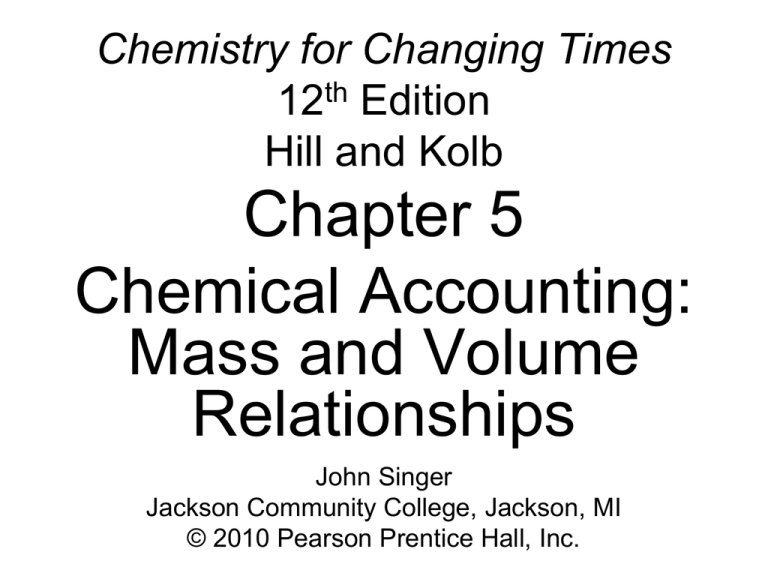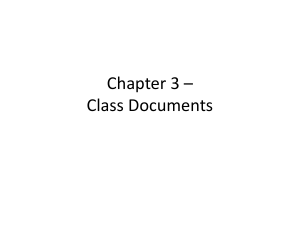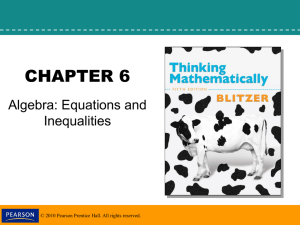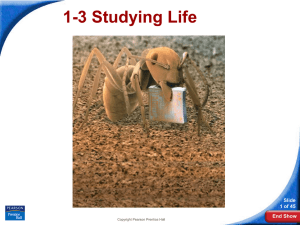
Chemistry for Changing Times
12th Edition
Hill and Kolb
Chapter 5
Chemical Accounting:
Mass and Volume
Relationships
John Singer
Jackson Community College, Jackson, MI
© 2010 Pearson Prentice Hall, Inc.
Chemical Sentences: Equations
Chemical equations represent the sentences in
the language of chemistry. They are the means
of communicating a chemical change using the
symbols and formulas to represent the elements
and compounds involved in a chemical reaction.
© 2010 Pearson Prentice Hall,
Inc.
5/2
Chemical Sentences: Equations
Reactants are the species present before the
reaction.
Products are the species present after the
reaction:
Reactants → Products
The arrow (→) means “yield(s)” or “react(s) to
produce”.
© 2010 Pearson Prentice Hall,
Inc.
5/3
Chemical Sentences: Equations
The following are used to denote the states of
matter of a species in an equation:
(s)
(l)
(g)
(aq)
=
=
=
=
solid
liquid
gas
aqueous solution
© 2010 Pearson Prentice Hall,
Inc.
5/4
Chemical Sentences: Equations
Coefficients are numbers used to balance a
chemical equation. Never change the
subscripts.
© 2010 Pearson Prentice Hall,
Inc.
5/5
Volume Relationships in
Chemical Equations
Law of Combined Volumes: When all
measurements are made at the same
temperature and pressure, the volumes of
gaseous reactants and products are in a small
whole-number ratio.
© 2010 Pearson Prentice Hall,
Inc.
5/6
Volume Relationships in
Chemical Equations
Avogadro’s hypothesis: When measured
at the same temperature and pressure,
volumes of all gases contain the same
number of molecules.
© 2010 Pearson Prentice Hall,
Inc.
5/7
Avogadro’s Number
Avogadro’s number is
defined as the number of
atoms in a 12-g sample of
carbon-12 and is:
6.02 x
23
10
© 2010 Pearson Prentice Hall,
Inc.
5/8
The Mole
A mole (mol) is defined as the
amount of a substance that contains
6.02 x 1023 particles.
© 2010 Pearson Prentice Hall,
Inc.
5/9
The Mole
© 2010 Pearson Prentice Hall,
Inc.
5/10
The Mole
Formula mass is the average mass of a formula
unit relative to that of a carbon-12 atom.
It is simply the sum of the atomic masses for all
atoms in a formula.
If the formula represents a molecule, often the
term molecular mass is used.
© 2010 Pearson Prentice Hall,
Inc.
5/11
The Mole
© 2010 Pearson Prentice Hall,
Inc.
5/12
The Mole
Molar volume of a gas: One mole of any gas
occupies a volume of 22.4 L at standard
temperature and pressure (STP).
STP is defined as 1 atmosphere (atm) of pressure
and a temperature of 0 oC.
© 2010 Pearson Prentice Hall,
Inc.
5/13
The Mole
© 2010 Pearson Prentice Hall,
Inc.
5/14
Mole and Mass Relationships in
Chemical Equations
© 2010 Pearson Prentice Hall,
Inc.
5/15
Mole and Mass Relationships in
Chemical Equations
Stoichiometry involves the quantitative
relationship between reactants and products in a
balanced chemical equation.
The coefficients of a balanced chemical equation
represent moles.
© 2010 Pearson Prentice Hall,
Inc.
5/16
Mole and Mass Relationships in
Chemical Equations
2 H 2 + O2 2 H 2 O
This equation can be read as follows:
2 mol of H2 reacts with one mol O2 to yield
2 mol of H2O.
© 2010 Pearson Prentice Hall,
Inc.
5/17
Mole and Mass Relationships in
Chemical Equations
Steps in a Stoichiometric Calculation:
1. Write and balance the chemical equation for
the reaction.
2. Determine molar masses of substances
involved in the calculation.
3. Use the coefficients of the balanced equation
to convert the moles of the given substance to
the moles of the desired substance.
4. Use the molar mass to convert the moles of
the desired substance to grams of the desired
substance.
© 2010 Pearson Prentice Hall,
Inc.
5/18
Mole and Mass Relationships in
Chemical Equations
© 2010 Pearson Prentice Hall,
Inc.
5/19
Solutions
The amount of solute in a given amount of
solvent is defined as solution concentration.
A dilute solution contains relative small
amounts of solute in a given amount of solvent.
A concentrated solution contains relatively
large amounts of solute in a given amount of
solvent.
© 2010 Pearson Prentice Hall,
Inc.
5/20
Solutions
Molarity (M) is defined as the moles of solute
per liter of solution.
mol
M=
liter
© 2010 Pearson Prentice Hall,
Inc.
5/21
Solutions
Percent Concentration
Percent by volume = volume of solute x 100
volume of solution
© 2010 Pearson Prentice Hall,
Inc.
5/22
Solutions
Percent Concentration
Percent by mass =
mass of solute
mass of solution
© 2010 Pearson Prentice Hall,
Inc.
x 100
5/23






